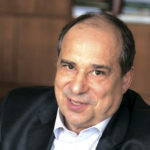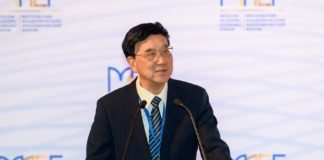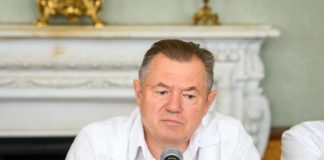The global economy has entered a potentially long period of turbulence. Many developed economies, previously vigorous proponents of liberal globalization of the world economic order, are now increasingly focusing on themselves. Vice-President of the Free Economic Society (VEO of Russia), member of the Russian Academy of Sciences Alexander Nekipelov spoke about Russia’s economic strategy and economic policy in the modern world in an interview with the Free Economy Journal.
 Alexander Nekipelov,
Alexander Nekipelov,
vice-president of the VEO of Russia, director of the Moscow School of Economics Moscow State University, Academician of the Russian Academy of Sciences, Doctor of Economics
— To what extent do you think the economic strategies and economic policies pursued in Russia are consistent with global economic trends?
— First of all, I would like to say that Russia’s economic strategy and economic policy have not remained the same; our approaches have changed significantly over time.
Although at the initial stage, we often heard that the best industrial policy is no industrial policy, this sphere has seen some dramatic changes by now. The National Projects are being implemented, and efforts are being made to build some vision of Russia’s future; the spatial development concept is being worked out.
The process is certainly difficult and sparks heated debate among specialists, which is only natural. There have been serious disputes over a number of economic strategy and policy aspects, as well as disagreements concerning standards and values because each expert can have their own ideas about what is good and what is bad. But it is quite natural that the regulator, the government, tends to rely on the prevailing ideas.
What I can see now is a shift in specific countries’ balance of benefits and losses from the new international division of labor triggered by the general developments in the global economy, which has apparently entered a rather long period of turbulence where the old rules of the economic (and not just economic) game are being questioned. What was once considered unambiguously beneficial is not so obvious anymore.
— Like what?
— Until recently, the most developed countries vigorously promoted the concept of liberal globalization of the world economic order. But the picture began to change after the financial and economic crises of recent years. Developed economies have begun to move production facilities they used to run in other states back home, and there is a growing understanding that, say, specialization in highly intellectual activities is also important and can bring serious benefits.
— Do you think Russia’s national goals and strategies that you mentioned are in line with the global economic trends, or is it a kind of lateral flow?
— I do not think there is any dominant trend, or unidirectional flow at this stage, which will apparently
last for quite a while — a phase where everyone is trying to adapt to the new realities, find their niche and fill it. In this sense, Russia is using the same approach, only there is no common vector for all countries now because they have not yet coordinated their behavior amid the new landscape of economic and state interests.
In this context, it seems expedient for Russia to make a number of decisions. One issue is highly ideologized — it is about the role of the state in the economy. It would be good to clear it from the ideology agenda — for example, to decide which problems the state should solve, and which ones could be left to the free market. There are a number of related questions about how much resources need to be concentrated in the hands of the state to solve problems. In any case, we need to maintain a correlation between the goals we have identified — which differ from a situation where the market would regulate itself — and the resources we are allocating for this.
By the most general considerations, I must say Russia belongs to a fairly liberal camp when it comes to the state’s financial involvement in the economy. The ratio of “extended government” spending to gross domestic product is slightly above 30%, compared to 40% in OECD as a group and up to 60% in some of the Scandinavian countries.
At the same time, one cannot say some countries are doing the right thing while others aren’t. It all depends on what society wants and what goals it faces, as well as what kind of resources should be in the hands of the state.
Personally, for Russia, I would say this figure should grow.
— To what level?
— Of course, this kind of growth cannot be secured in one day. We need to determine a growth strategy that will be approved by and clear to everybody. Thirty- something percent is not enough to modernize our economy. I think what we need to achieve is at least 40 percent — but provided that, all economic agents are ready for this.
— What about a larger target, a guiding star of our economic strategy? Where should Russia go?
— Our main direction was mapped out long time ago — and it is, in fact, the right direction. We need to upgrade our production capacities. We lost many high- tech industries due to our very liberal approach to shifting to a market economy. Obviously, there is no point in recreating everything as it was before, but we must pursue this path and we do have the resources for it, including intellectual assets.
Also, considering the turbulence of the global economy, we should understand that in the foreseeable future, we will have to concentrate on self-reliance and steer away from cooperation with others. This does not mean that autarky should be our goal. Of course, not. But where Russia stands right now, we will need to largely rely on ourselves and on cooperation with the countries that are more or less clearly willing to cooperate with us.
— A strategy means that there must be a step-by- step action plan. In your opinion, what should be our first steps towards the main goal?
— We are moving in this direction. National projects are one of the steps. What we also should do is support the strategy with instruments because even specific efforts need to be “grounded” to prevent them from just hanging in the air.
— What specific adjustments do we need to make to Russia’s existing economic policy in order to make sure that our country moves in the right direction and catches up with developed countries? What constant parameters should we rely on?
— Laws and changing regulations — yes, we do see all this happening. The parliament is making necessary adjustments in order to fulfill certain tasks. But I would like to stress the following: issues of a more global nature need to be resolved after we get a clear understanding of what exactly we want to do and what economic policy we intend to pursue.
Of course, it does not mean that we must immediately stop making changes to our legislation. It simply means we should more carefully consider the substantive matters, decide on our approach to them and change the rules of the game based on that.
— Can you name at least a few of these substantive matters?
— I can tell you how I understand it. You see, the first thing we need to understand is that the economic policy of the government is a comprehensive policy. Why is it important? Because when we speak about a comprehensive policy, the main question is if we agree with the goals that are set and the way they are achieved.
A while ago, Russia found a very unusual method to mitigate the adverse consequences of the “Dutch disease.” This phenomenon is common for countries with a significant share of the fuel and energy sector in their economies. Essentially, faster development of this sector makes it very difficult to maintain processing industries and the industries that determine the technological progress. But as I imagine, the goal was to ensure that inflation is low while the non-commodity sector remains highly competitive.
That meant that, along with low inflation, we needed to maintain a lower exchange rate for the ruble in purchasing power adjusted dollars. If we look at the general results of Russia’s economic development, we will see that the inflation rate has reduced significantly. For example, in December 2014, the inflation rate was 11.5% year-on-year; but in 2020, it was 4.9%. We also managed to maintain the lower exchange rate for the ruble. In 2014, the unofficial rate against the purchasing power parity was around 60%, or 40% too low. In 2017, it was 50% too low.
— These tasks are often mutually exclusive.
— Economic theory has proven that a proper organization of the money and credit sector allows for setting tasks by only a single indicator, while our task aimed at targeting both goals and linking it to the efforts to tackle the “Dutch disease” as well as to preserve efficiency of processing industries.
This was achieved by the Central Bank sharing its functions with the Ministry of Finance, which started using part of the resources to forward them to the National Welfare Fund, a major part of those converted into currency or foreign currency assets, with the Central Bank acting as operator. So we have these
finances included in our international reserves. Yet, unlike what had taken place before the fall of 2013, the Ministry of Finance bought currency in the market rather than directly from the Central Bank, thus taking on the role of interventions.
These efforts helped support the decreased exchange rate of the ruble and reduce the inflation, and preserve competitiveness and non-resource production.
— But this process cannot take place without causing certain expenses…
— Of course, expenses are there — for instance, Russia’s exports exceeded its imports by $60 bln per year, meaning the country basically provided considerable loans to the rest of the world. If the Ministry of Finance had not taken part in interventions in the currency market, the ruble exchange rate would have been higher and the interest rate would ultimately have been different.
Consumers definitely benefited from the lower prices for imports — yet the industry would have been drastically affected.
In such circumstances, it proved impossible to use the National Welfare Fund resources as a safety cushion. From December 2019 through December 2020, amidst the pandemic, the fund grew from RUR 7.7 tln ($104 bln) to RUR 13.5 tln ($182.4 bln), and it reached RUR 13.8 tln ($186.5 bln) in March 2021.
Yet I would like to say that this is an inevitable effect of the chosen economic policy — the reverse side of what we have achieved as regards inflation and preserving competitiveness through exaction of resources from circulation.
I personally believe we have to carry out comprehensive changes to the whole scope of issues.
— What do you mean by these changes?
— First, I agree with my colleagues who claim we have to abandon overly harsh approaches to the fight against inflation as the latter serves as a kind of economic lubricant for the economy — unless it is too high, of course.
I believe we should go back to normal relations between monetary and financial authorities. The issue of market interventions should be within the competence of the Central Bank. We have to take efforts to develop and implement the schedule for gradual reduction of the Central Bank’s key interest rate to the global level, probably only slightly higher. This will reduce net inflows of foreign currency and increase our imports — consequently, we will have to start spending National Welfare Fund resources.
We should also abandon the policy of the twofold- reduced purchasing power parity of the ruble as well as the practice of the Central Bank’s absorption of excess money reserves through creating special accounts for banks to keep excess liquidity.
— But there are no profitable projects for banks to invest in.
— It works both ways: the lack of profitable projects is due to the high interest rate, among other factors. In case it is reduced as part of a sustainable policy, the number of economically efficient projects will grow.
— Speaking of the policy, you have mentioned that Russia’s development requires a sort of a common idea, some megaproject that would provide
a development vector for decades to come. What do you think could serve as such a megaproject and why?
— There is a project sometimes called The Second Trans–Siberian Railway, which includes building a high-speed railway across Russia’s territory and adjacent logistic centers to create the country’s transportation and logistic network to provide opportunities for territory development. This is a long- term project tailored for decades to come; it involves massive investment efforts — yet it can be handled by both the government and the business. The costs of the project implementation are estimated at some $300– 320 bln.
I would like to note that this project would benefit from involving foreign partners as it will make an immense contribution to advancement of the global transport infrastructure.



